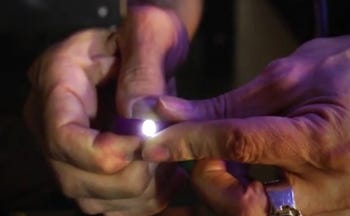World's most-conductive 3D-printing filament now shipping
Start-up Functionalize Inc. (Seattle, WA) announced today that it has beaten the promised electrical specification of F-Electric, its conductive 3D-printing filament, by 25% and has begun customer shipments. The final production material has a resistance of 0.75 Ω/cm and has greater mechanical strength than the beta material or virgin PLA. Described as the world's most conductive 3D-printing filament, F-Electric is the first plastic filament that enables 3D printing of circuit boards, flashlights, lighted wearables and more, according to the company.
April 2, 2015
Start-up Functionalize Inc. (Seattle, WA) announced today that it has beaten the promised electrical specification of F-Electric, its conductive 3D-printing filament, by 25% and has begun customer shipments. The final production material has a resistance of 0.75 Ω/cm and has greater mechanical strength than the beta material or virgin PLA. Described as the world's most conductive 3D-printing filament, F-Electric is the first plastic filament that enables 3D printing of circuit boards, flashlights, lighted wearables and more, according to the company.
Speaking at the second annual Additive Disruption Summit in Santa Clara, CA, Mike Toutonghi, CEO and founder of Functionalize Inc., said the company and its manufacturing partner Protoparadigm, a supplier of premium 3D-printing filaments, were "super excited that we were able to get our process into production and ship it in March. More than that, we're pleased to deliver a product that exceeds both our electrical and mechanical property goals," he said.
 Since its introduction, F-Electric filament has been available on a limited, sample-only basis. Still, a few creative folks have designed some very interesting 3D-printed electronic projects using the filament, says Toutonghi. Among the projects, he cites a flashlight produced on a single-head printer by Mosaic Manufacturing and a fully 3D printed robot by Adrian Bowyer, CEO of RepRapPro Ltd. in the UK and founder of the RepRap project, which aims to develop a self-replicating 3D printer that can print most of its own components.
Since its introduction, F-Electric filament has been available on a limited, sample-only basis. Still, a few creative folks have designed some very interesting 3D-printed electronic projects using the filament, says Toutonghi. Among the projects, he cites a flashlight produced on a single-head printer by Mosaic Manufacturing and a fully 3D printed robot by Adrian Bowyer, CEO of RepRapPro Ltd. in the UK and founder of the RepRap project, which aims to develop a self-replicating 3D printer that can print most of its own components.
"Imagine the possibility of today's 3D-printed prosthetics being able to sense pressure through conductive pads in the fingertips, printable robots that people could share and improve, or active wearables as creative as their maker," says Toutonghi. "We're excited to be at the beginning of this trend. Shipping F-Electric is a historic milestone for our company and our customers. We've provided a new tool, and I can't wait to see what creative people do with it."
For more on this innovative company and to learn about its origins, read the PlasticsToday interview of Toutonghi in an article we published in December 2014, "New 3D-printing filament is 1000 times more conductive than existing technology."
About the Author(s)
You May Also Like


